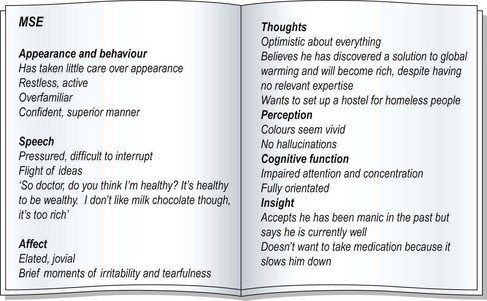Bipolar disorder – clinical presentation and management
Clinical presentation of mania
In manic episodes, there are characteristic changes in mood, biological functions and thinking, and in severe cases psychotic symptoms develop. The symptoms and signs commonly encountered are described below and a typical mental state examination of a person with mania is shown in Figure 1. A manic episode is not usually diagnosed until typical features of the illness have been present for at least a week.
Depressive episodes
Bipolar depression presents in the same way as unipolar depressive episodes, the clinical features of which are described on pages 52–53. The only way to establish whether a depressive episode is part of a unipolar or bipolar disorder is to check for a history of manic episodes. There are, however, features of depressive episodes that can suggest the possibility of bipolar disorder – psychotic symptoms, severe agitation suggestive of a mixed affective state, atypical symptoms such as increased sleep and appetite, and poor response to antidepressant drugs are all suggestive of bipolar depression and should prompt a review of the case, to check whether a history of manic episodes has been missed.
Stay updated, free articles. Join our Telegram channel

Full access? Get Clinical Tree




